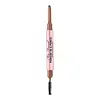KVD Vegan Beauty 24-Hour Super Brow Long-Wear Pomade Versus Too Faced Pomade In A Pencil Eyebrow Shaper & Filler
What's inside
What's inside
 Key Ingredients
Key Ingredients

 Benefits
Benefits

 Concerns
Concerns

No concerns
 Ingredients Side-by-side
Ingredients Side-by-side

Isododecane
EmollientTrimethylsiloxysilicate
EmollientDimethicone
EmollientKaolin
AbrasivePolyethylene
AbrasiveSilica
AbrasivePhenoxyethanol
PreservativeSodium Myristoyl Sarcosinate
CleansingCaprylyl Glycol
EmollientDisteardimonium Hectorite
StabilisingLecithin
EmollientSynthetic Fluorphlogopite
Aluminum Hydroxide
EmollientTocopheryl Acetate
AntioxidantPropylene Carbonate
SolventBHT
AntioxidantIron Oxides
CI 77891
Cosmetic ColorantTrimethylsiloxysilicate
EmollientMethyl Trimethicone
Skin ConditioningSynthetic Fluorphlogopite
Polyethylene
AbrasiveDipentaerythrityl Pentaisostearate
EmollientEuphorbia Cerifera Wax
Dimethicone
EmollientPrunus Armeniaca Kernel Oil
MaskingMacadamia Ternifolia Seed Oil
EmollientAluminum Hydroxide
EmollientSorbitan Isostearate
EmulsifyingTocopherol
AntioxidantCI 77891
Cosmetic ColorantCI 77491
Cosmetic ColorantCI 77492
Cosmetic ColorantCI 77499
Cosmetic ColorantTrimethylsiloxysilicate, Methyl Trimethicone, Synthetic Fluorphlogopite, Polyethylene, Dipentaerythrityl Pentaisostearate, Euphorbia Cerifera Wax, Dimethicone, Prunus Armeniaca Kernel Oil, Macadamia Ternifolia Seed Oil, Aluminum Hydroxide, Sorbitan Isostearate, Tocopherol, CI 77891, CI 77491, CI 77492, CI 77499
Ingredients Explained
These ingredients are found in both products.
Ingredients higher up in an ingredient list are typically present in a larger amount.
Aluminum Hydroxide is a form of aluminum. It can be naturally found in nature as the mineral gibbsite. In cosmetics, Aluminum Hydroxide is used as a colorant, pH adjuster, and absorbent.
As a colorant, Aluminum Hydroxide may add opacity, or reduce the transparency. Aluminum hydroxide is contains both basic and acidic properties.
According to manufacturers, this ingredient is an emollient and humectant. This means it helps hydrate the skin.
In medicine, this ingredient is used to help relieve heartburn and help heal ulcers.
There is currently no credible scientific evidence linking aluminum hydroxide in cosmetics to increased cancer risk.
Major health organizations allow the use of aluminum hydroxide in personal care products and have not flagged it as a carcinogenic risk at typical usage levels.
Learn more about Aluminum HydroxideCi 77891 is a white pigment from Titanium dioxide. It is naturally found in minerals such as rutile and ilmenite.
It's main function is to add a white color to cosmetics. It can also be mixed with other colors to create different shades.
Ci 77891 is commonly found in sunscreens due to its ability to block UV rays.
Learn more about CI 77891Dimethicone is a type of synthetic silicone created from natural materials such as quartz.
What it does:
Dimethicone comes in different viscosities:
Depending on the viscosity, dimethicone has different properties.
Ingredients lists don't always show which type is used, so we recommend reaching out to the brand if you have questions about the viscosity.
This ingredient is unlikely to cause irritation because it does not get absorbed into skin. However, people with silicone allergies should be careful about using this ingredient.
Note: Dimethicone may contribute to pilling. This is because it is not oil or water soluble, so pilling may occur when layered with products. When mixed with heavy oils in a formula, the outcome is also quite greasy.
Learn more about DimethiconePolyethylene is a synthetic ingredient that helps the skin retain moisture. It is a polymer.
It is also typically used within product formulations to help bind solid ingredients together and thicken oil-based ingredients. When added to balms and emulsions, it helps increase the melting point temperature.
Synthetic Fluorphlogopite is the synthethic version of mica. It consists of fluorine, aluminum and silicate.
Synthetic Fluorphlogopite is used to add volume to products.
It is considered non-irritating on the skin.
Learn more about Synthetic FluorphlogopiteThis silicone is an emollient. Emollients create a thin film on the skin to prevent moisture from escaping.
It is not soluble in water and helps increase water-resistance in products.
According to a manufacturer, it can blend seamlessly with silicone oils, such as Cyclopentasiloxane.
Learn more about Trimethylsiloxysilicate